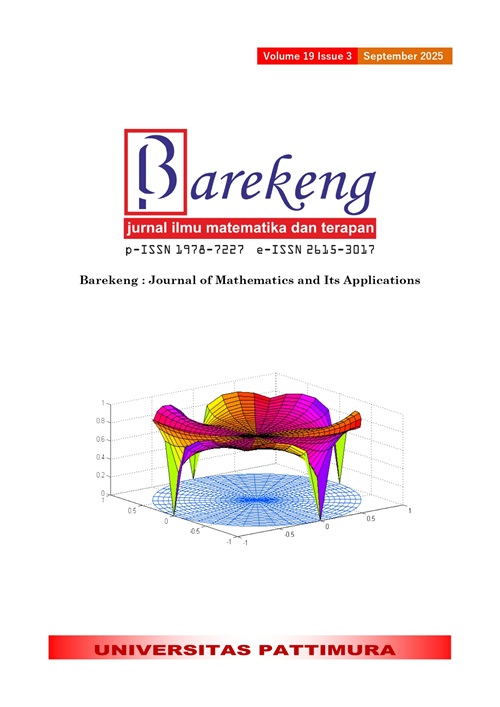OPTIMIZING DEFINED BENEFIT PENSION PLAN FUNDING: COMBINING ENTRY AGE NORMAL METHOD AND SINGLE SALARY APPROACH
Abstract
The sustainability of defined benefit pension plans relies heavily on effective funding strategies. This study aims to develop an optimized funding strategy for Defined Benefit Pension Plans by integrating the Entry Age Normal (EAN) method with the Single Salary Approach (SSA). The Entry Age Normal method provides a systematic way to distribute the cost of pension benefits over the career of employees, ensuring long-term stability. Meanwhile, the Single Salary Approach simplifies salary projections, making it easier to manage fund contributions while accounting for future wage inflation. To evaluate the effectiveness of this integrated approach, we conducted a case study using salary and pension fund data collected from internal records at Institut Teknologi Bacharuddin Jusuf Habibie (ITH), a higher education institution. Through a series of simulations and sensitivity analyses, we demonstrate that integrating these methods not only minimizes funding volatility but also improves the accuracy of pension liabilities estimation. For instance, at age 25.83, the actuarial liability is Rp 38,929,501, reflecting a relatively low liability at a younger age. As employees approach retirement, the liability increases significantly. At age 47.17, the liability reaches Rp 191,823,284, demonstrating the impact of salary growth and length of service on future benefits. Additionally, for the same age of 25.83, the actuarial liability under SSA-EAN is Rp 37,980,001, which is slightly lower than the EAN estimate. Pension benefits projected under SSA-EAN are also slightly lower than those under EAN, indicating potential cost savings. The findings provide a viable framework for pension plan administrators seeking to achieve both financial sustainability and predictability in managing pension obligations. By integrating SSA with EAN, this study offers a practical solution that addresses key challenges in the actuarial valuation of defined benefit plans, ensuring more stable and predictable pension funding.
Downloads
References
J. Ai, P. L. Brockett, and A. F. Jacobson, “A NEW DEFINED BENEFIT PENSION RISK MEASUREMENT METHODOLOGY,” Insur. Math. Econ., vol. 63, pp. 40–51, Jul. 2015, doi: https://doi.org/10.1016/j.insmatheco.2015.03.027.
D. Hainaut and G. Deelstra, “OPTIMAL FUNDING OF DEFINED BENEFIT PENSION PLANS,” J. Pension Econ. Finance, vol. 10, no. 1, pp. 31–52, Jan. 2011, doi: https://doi.org/10.1017/S1474747210000016.
GARP, R. Apostolik, and C. Donohue, FOUNDATIONS OF FINANCIAL RISK: AN OVERVIEW OF FINANCIAL RISK AND RISK-BASED FINANCIAL REGULATION, 2nd edition. Hoboken, New Jersey: Wiley, 2015.
M. Strumskis and A. Balkevičius, “PENSION FUND PARTICIPANTS AND FUND MANAGING COMPANY SHAREHOLDER RELATIONS IN LITHUANIA SECOND PILLAR PENSION FUNDS,” Intellect. Econ., vol. 10, no. 1, pp. 1–12, Apr. 2016, doi: https://doi.org/10.1016/j.intele.2016.06.004.
G. Monroe, THE ONLY RETIREMENT PLANNING BOOK YOU’LL EVER NEED: YOUR GUIDE TO A STRESS-FREE RETIREMENT: ACHIEVE FINANCIAL FREEDOM, MAKE YOUR MONEY LAST, & SAVOR LIFE AFTER WORK.
G. S. Goda, M. Levy, C. F. Manchester, A. Sojourner, and J. Tasoff, “PREDICTING RETIREMENT SAVINGS USING SURVEY MEASURES OF EXPONENTIAL-GROWTH BIAS AND PRESENT BIAS,” Econ. Inq., vol. 57, no. 3, pp. 1636–1658, 2019, doi: https://doi.org/10.1111/ecin.12792.
Mr. K. C. Chauhan, “EFFECTIVE PENSION FUND MANAGEMENT STRATEGY: A COMPREHENSIVE STUDY WITH METHODOLOGICAL INSIGHTS FROM THE INDIAN FINANCIAL LANDSCAPE,” Int. J. Multidiscip. Res., vol. 6, no. 2, p. 15157, Mar. 2024, doi: https://doi.org/10.36948/ijfmr.2024.v06i02.15157.
J. M. Bravo, M. Ayuso, R. Holzmann, and E. Palmer, “INTERGENERATIONAL ACTUARIAL FAIRNESS WHEN LONGEVITY INCREASES: AMENDING THE RETIREMENT AGE,” Insur. Math. Econ., vol. 113, pp. 161–184, Nov. 2023, doi: https://doi.org/10.1016/j.insmatheco.2023.08.007.
A. Angkasa, D. Lestari, and S. Devila, “COMPARISON OF ENTRY AGE NORMAL AND PROJECTED UNIT CREDIT METHOD FOR FUNDING OF DEFINED BENEFIT PENSION PLAN,” presented at the AIP Conference Proceedings, Jul. 2021, p. 030003. doi: https://doi.org/10.1063/5.0059248.
L. D. Sanches-António, “RELATIONSHIP BETWEEN STARTING SALARY AND CATEGORICAL VARIABLES,” 2024.
E. Pratiwi, F. Ningtyas, R. Kamilia, Z. Nabilia, and A. Prabowo, “DE MOIVRE LAW APPLICATION FOR THE CONSTRUCTION OF MORTALITY TABLES BASED ON INDONESIAN MORTALITY TABLES 2019,” Int. J. Quant. Res. Model., vol. 3, pp. 181–188, Nov. 2022, doi: https://doi.org/10.46336/ijqrm.v3i4.357.
R. Josa-Fombellida, P. López-Casado, and J. P. Rincón-Zapatero, “PORTFOLIO OPTIMIZATION IN A DEFINED BENEFIT PENSION PLAN WHERE THE RISKY ASSETS ARE PROCESSES WITH CONSTANT ELASTICITY OF VARIANCE,” Insur. Math. Econ., vol. 82, pp. 73–86, Sep. 2018, doi: https://doi.org/10.1016/j.insmatheco.2018.06.011.
G. Ogungbenle and J. Adeyele, “COMPARISON MECHANICS OF NORMAL COST OF FIXED PENSION PLANS FUNDING POLICY UNDER PROJECTED UNIT AND THE ENTRY AGE METHODS,” vol. 4, pp. 348–362, Jul. 2018.
“The RP-2000 Mortality Tables,” 2024.
W. Ekasasmita, N. Rahmi, and M. F. Iskandar, “EMPLOYEE BENEFITS PROGRAM VALUATION WITH MULTIPLE DECREMENT MODEL BASED ON PSAK 24 POST-COVID-19 PANDEMIC,” JTAM J. Teori Dan Apl. Mat., vol. 8, no. 1, pp. 123–136, Jan. 2024, doi: https://doi.org/10.31764/jtam.v8i1.17417.
S. Riaman, “CALCULATION OF PENSION FUNDS WITH ENTRY AGE NORMAL AND ATTAINED AGE NORMAL APPROACHES IN THE PROJECTED BENEFIT COST METHOD.” Accessed: Aug. 28, 2024. [Online]. Available: https://ieomsociety.org/proceedings/2021indonesia/678.pdf
C. Thompson and P. Hopkin, FUNDAMENTALS OF RISK MANAGEMENT: UNDERSTANDING, EVALUATING AND IMPLEMENTING EFFECTIVE ENTERPRISE RISK MANAGEMENT, 6th edition. London ; New York: Kogan Page, 2021.
E. Pykhova, OPERATIONAL RISK MANAGEMENT IN FINANCIAL SERVICES: A PRACTICAL GUIDE TO ESTABLISHING EFFECTIVE SOLUTIONS, 1st edition. New York: Kogan Page, 2021.
Copyright (c) 2025 Wahyuni Ekasasmita, Nur Rahmi, Khaera Tunnisa, Muhammad Ikhlashul Amal

This work is licensed under a Creative Commons Attribution-ShareAlike 4.0 International License.
Authors who publish with this Journal agree to the following terms:
- Author retain copyright and grant the journal right of first publication with the work simultaneously licensed under a creative commons attribution license that allow others to share the work within an acknowledgement of the work’s authorship and initial publication of this journal.
- Authors are able to enter into separate, additional contractual arrangement for the non-exclusive distribution of the journal’s published version of the work (e.g. acknowledgement of its initial publication in this journal).
- Authors are permitted and encouraged to post their work online (e.g. in institutional repositories or on their websites) prior to and during the submission process, as it can lead to productive exchanges, as well as earlier and greater citation of published works.






1.gif)



